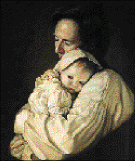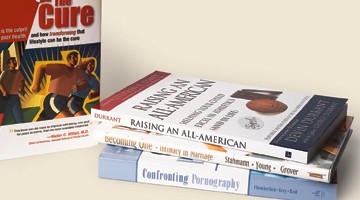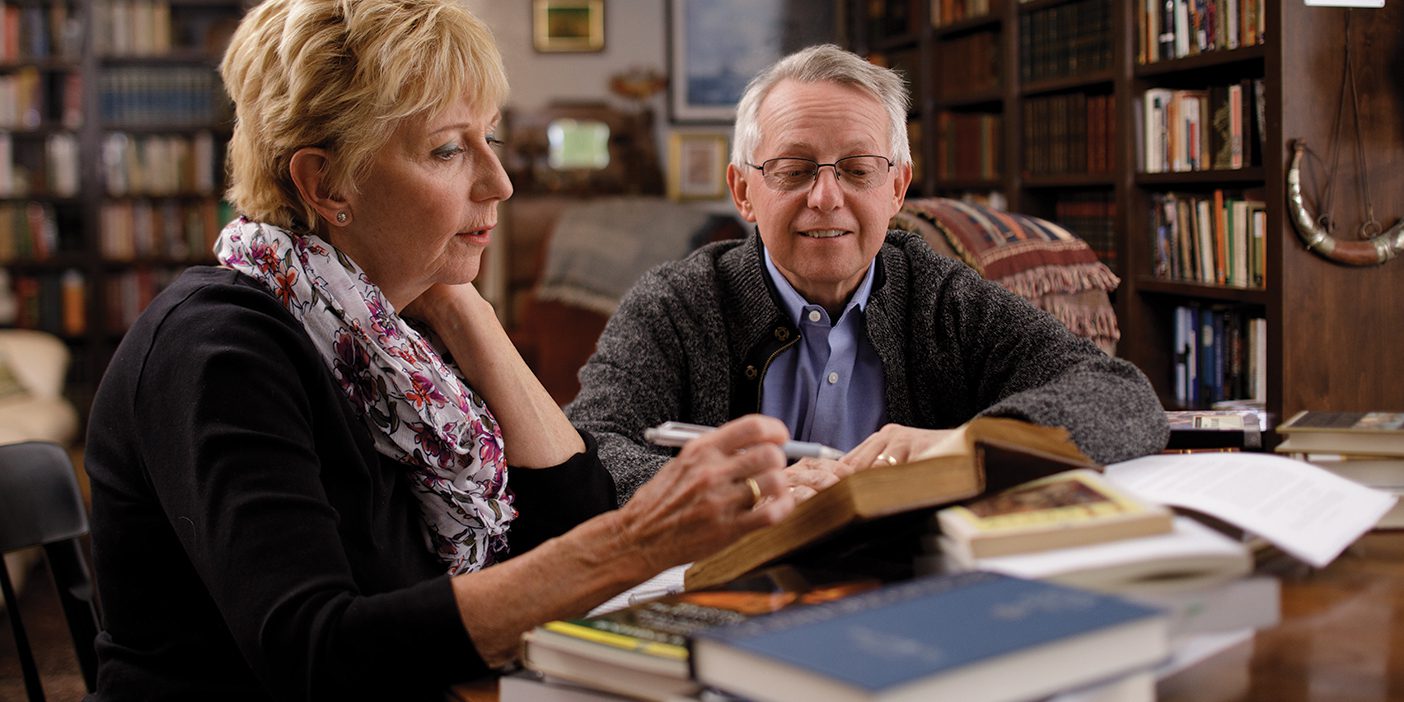By Richard H. Cracroft
The alumni of Brigham Young University enjoy success not only in obeying the Lord’s injunction to “seek ye out of the best books words of wisdom” (D&C 88:118), but also in the variety and richness of their contributions in researching and writing those “best books.” To illustrate my point, I invite you to accompany me through a quick sampling of recent books by an impressive array of BYU alumni.
Let us begin with a book that is receiving international attention. Nafanua: Saving the Samoan Rain Forest (New York: W.H. Freeman, 1997; 238 pp.; $23.95) is a “moving and haunting memoir by one of the finest ethnobotanists working in the South Pacific”: Paul Alan Cox, BYU professor of botany. Nafanua is a beautifully written account of Cox’s work  among the forests and villages of Samoa. In a rich melding of personal and scientific discovery, Cox describes modern-day threats to a Samoan society that is neither primitive nor industrial, documents discoveries that may contribute to the fight against diseases such as AIDS, recounts his adventure in assisting with the rebuilding of a village destroyed by a hurricane, and describes his international campaign to save the rain forest from economic exploitation and destruction. This is an extraordinary book about extraordinary accomplishments by an extraordinary man.
among the forests and villages of Samoa. In a rich melding of personal and scientific discovery, Cox describes modern-day threats to a Samoan society that is neither primitive nor industrial, documents discoveries that may contribute to the fight against diseases such as AIDS, recounts his adventure in assisting with the rebuilding of a village destroyed by a hurricane, and describes his international campaign to save the rain forest from economic exploitation and destruction. This is an extraordinary book about extraordinary accomplishments by an extraordinary man.
Another important publishing event for those who love poetry (i.e., those destined for the Celestial Kingdom) is Lance Larsen’s collection of 36 finely crafted poems,Erasable Walls (Kalamazoo, Mich.: New Issues Press, 1998; 66 pp.; $12). The title poem alludes to “a flexibility in relationships, something transitory and open-ended,” which enables deep diving into the depths of the soul, via the human senses. Larsen gets at his own “religious solitude” through moving and profound sensory perception, examining his and our internality in rich and delicious images, as in these lines from “Woman Addressing the Moon”: “I want to sing without God burning in my mouth./Or sit in a perfumed bath/and feel oceans lapping inside me. . . . / My kisses to the air will bring rain./ . . . I will return to a country/green with fountains and tree frogs/where I believed I was pure/and I was.” A craftsman of moving, vivid, and powerful verse that affirms the importance of our senses to our mortal and spiritual perception, Larsen is an assistant professor of English and creative writing at BYU.
Tom Plummer, a BYU professor of Germanic and Slavic languages, enters the rare arena of the “very-funny-but-incisive personal essay” with Eating Chocolates and Dancing in the Kitchen (Salt Lake City: Shadow Mountain, 1998; 159 pp.; $16.95). Tom’s wife, Louise, herself a best-selling author, sets the tone in her “let me tell you about our marriage” introduction, whereupon Tom unfolds 16 warm, delightful, and often hilarious essays that explore the perils of being married to a woman–in particular to Louise. There isn’t a husband or wife anywhere who won’t chuckle at such essays as “I Married an Aesthete,” “OD’d on Shrimp,” and “‘Love’s Old Sweet Song.'” Who can forget Tom’s defusing a spat by picking the lock on Louise’s bathroom door and climbing–shoed, socked, tie-d, and sport-coated–into his amused (and forgiving) wife’s tub-for-one?
As Latter-day Saints have sharpened their focus on serious social problems which beset family and church, BYU alumni have written a number of fine guidebooks to help saints cope.A Place in the Kingdom: Spiritual Insights from Latter-day Saints about Same-Sex Attraction (Salt Lake City: Evergreen International; 211 pp.; $17), edited by Garrick Hyde and Ginger Hyde, is a timely book of essays by some who have experienced or observed up-close the significance of same-sex attraction but have struggled to live in accordance with Latter-day Saint codes of moral conduct.
In a refreshing book for the parents of teenagers, Susan Noyes Anderson has written a practical, hopeful, and even poetic book, At the End of Your Rope, There’s Hope: Parenting Teens in Crisis (Salt Lake City: Deseret Book, 1997; 146 pp.; $14.95). And for all of us who need some support in shaping a happy and Christ-centered family life, H. Wallace Goddard has drawn upon years of experience as professor of human development and family studies at Auburn, and two terms as a Mormon bishop, to write The Frightful and Joyous Journey of Family Life: Applying Gospel Insights in the Home (Salt Lake City: Bookcraft, 1997; 178 pp.; $13.95).
You who relish any work about the Prophet Joseph Smith, as I do, will rejoice in Ephraim Hatch’s Joseph Smith Portraits: A Search for the Prophet’s Likeness(Provo: BYU Religious Studies Center, 1998; 112 pp.; $18.95). In this profusely illustrated volume, Hatch

Joseph Smith: Impressions of a Prophet, a new release by Deseret Book, features Liz Lemon Swindle’s compelling portrayals of the Prophet of the Restoration, including this one: “While Emma Sleeps.”
graphically and methodically presents the results of his long search for an accurate portrait of the Prophet Joseph. Hatch’s quest included examinations of numerous eye-witness descriptions, the physical traits of the Smith and Mack families, the death masks, and other artifacts. Overlaying his findings on all existing artistic renderings of the Prophet, Hatch presents William Whitaker’s oil-on-canvas portrait (1996) as the likeness that, in his informed opinion, comes closest to portraying the features of the Prophet Joseph Smith. Thanks to fascinating detective work by one who reveres the Prophet, “millions shall know ‘Brother Joseph’ again” (“Praise to the Man,” Hymns, no. 27).
The art and commentary of Liz Lemon Swindle and the prose of Susan Easton Black combine felicitously in the stunning Joseph Smith: Impressions of a Prophet(Salt Lake City: Deseret Book, 1998; 108 pp.; $34.95). Featuring some 30 paintings, Impressions of a Prophet makes available Swindle’s fresh and vibrant portrayals of Joseph as a family man, husband, father, brother, son, and prophet. The paintings are complemented by Black’s historical commentary centered on the words and feelings of those close to the Prophet in life.
Two recent entertaining fictional fusions of LDS history and imagination are volumes one and two in Tom Roulstone’s pioneer-era trilogy, One Against the Wilderness (Springville, Utah: Cedar Fort, 1996; 267 pp.; $12.95) and Fleeing Babylon (Springville, Utah: Cedar Fort, 1998; 234 pp.; $13.95). Although Roulstone, a history professor at Northern Lights College in British Columbia, anchors his tales in LDS history, his novels are not, strictly speaking, historical novels, but exciting, adventure-packed romances set in a well-researched historical background. In One Against the Wilderness, Deirdre O’Connor’s search for her father lands her in Nauvoo in 184748. Sympathetic to but aloof from Mormonism, Deirdre participates in the flight from Nauvoo. While crossing the plains, however, she steps out of history and into a James Fenimore Cooper-like adventure in which she becomes “one against the wilderness,” eluding capture by Indians and testing her mettle, her love for two different men, and her growing belief in Mormonism. In volume two, Fleeing Babylon, Brigham Young calls Deirdre’s newly acquired fiancé on a mission and calls her to teach Mormon youth in San Francisco–the rough, wide-open, wicked “Babylon” of the title. After an exciting journey to San Francisco, she begins teaching Mormon children under the direction of the colorful and historical Sam Brannan, Mormon apostate, entrepreneur, and vigilante. Deirdre faces the temptations of a former sweetheart and survives an adventurous return to Utah Territory before finding happiness-ever-after–at least until volume three (projected for August 2000).
I heartily recommend two other novels you’ll enjoy: Kathryn H. Kidd has done it again in Return to Paradise (Greensboro, N.C.: Hatrack River; Salt Lake City: Publisher’s Press, 1997; 207 pp.; $8.95), a very funny sequel to her very funny Paradise Vue. We follow the further adventures of Amy Hardisty, young widow and fledgling ward newspaper editor in Paradise Vue Ward, where she innocently becomes the subject of gossip and foolish and precipitous leaps to misjudgment. While unraveling the confusion, Kidd makes trenchant comments about human nature and leads us to hope that there will be, around the corner, a Paradise Redux. Chris Heimerdinger has outdone his “Tennis Shoes” quartet of Book of Mormon time-travel novels in beginning a new series with Tennis Shoes and the Seven Churches, Book One (American Fork, Utah: Covenant, 1997; 329 pp.; $12.95). Harry Hawkins takes his turn in this novel, telling how a motorcycle accident that threatens Melody’s life launches family members on a quest for her beloved, who, instead of being found in Book of Mormon lands, is located in Jerusalem and the New Testament times of the first century A.D.
Do you see what I mean? Collectively and individually, BYU authors are making major contributions, advancing the university mission, and prospering the purposes of the Church–all this with a literature that seeks to cultivate “anything virtuous, lovely, or of good report or praiseworthy” (A of F 13) as we strive to understand the nature, purpose, and importance of the human condition.
Richard H. Cracroft, professor of English and director of the Center for the Study of Christian Values in Literature, has taught American, Western, and LDS literature at BYU since 1963.









